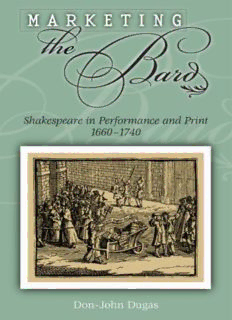
Marketing the Bard: Shakespeare in Performance and Print, 1660-1740 PDF
Preview Marketing the Bard: Shakespeare in Performance and Print, 1660-1740
(cid:2) M A R K E T I N G B (cid:2) e ar (cid:2) (cid:2) M A R K E T I N G B (cid:2) e ar (cid:2) Shakespeare in Performance and Print 1660–1740 Don-John Dugas UNIVERSITY OF MISSOURI PRESS COLUMBIA AND LONDON Copyright © 2006 by The Curators of the University of Missouri University of Missouri Press, Columbia, Missouri 65201 Printed and bound in the United States of America All rights reserved 5 4 3 2 1 10 09 08 07 06 Library of Congress Cataloging-in-Publication Data Dugas, Don-John, 1967– Marketing the bard : Shakespeare in performance and print, 1660–1740 / Don-John Dugas. p. cm. Summary: “Dugas credits the reemergence of Shakespeare’s plays and his rise to fame in the 1700s to economic factors surrounding the theater business including the acquisition and adaptation of Shakespeare’s plays by the Tonson publishing firm, which marketed collector’s editions of his work, spurring a price war and rousing public interest”—Provided by publisher. Includes bibliographical references and index. ISBN-13: 978-0-8262-1688-5 (alk. paper) ISBN-10: 0-8262-1688-9 (alk. paper) 1. Shakespeare, William, 1564–1616—Appreciation—England. 2. Shakespeare, William, 1564–1616—Bibliography. 3. Drama—Publishing— England—History—17th century. 4. Drama—Publishing—England—History— 18th century. 5. Shakespeare, William, 1564–1616—Stage history—1625–1800. 6. Shakespeare, William, 1564–1616—Adaptations—History and criticism. 7. J. and R. Tonson. I. Title. PR2971.G7D84 2006 822.3'3—dc22 2006015936 ™This paper meets the requirements of the American National Standard for Permanence of Paper for Printed Library Materials, Z39.48, 1984. Designer: foleydesign Typesetter: Crane Composition, Inc. Printer and binder: The Maple-Vail Book Manufacturing Group Typefaces: Bickham Script and ITC Veljovic for Robert D. Hume Contents Preface ix Acknowledgments xiii 1. Shakespeare as Performance Commodity, 1660–1705 1 I. Who Shapes Taste? 2 II. The Late-Seventeenth-Century Audience and Shakespeare 6 III. Shakespeare Adaptation, 1660–1667 22 IV. Shakespeare Adaptation, 1668–1682 43 V. Shakespeare Adaptation, 1683–1705 54 VI. The Influence of the Actors 59 2. Shakespeare as Textual Commodity, 1660–1708 69 I. The Influence of Publishers in the Creation of Canonical Literature 74 II. Late-Seventeenth-Century Play Readers 80 III. The Post-Restoration Quartos 82 IV. Expanding the Canon: Chetwind and the Third Folio 91 V. Herringman and the Fourth Folio 109 VI. Tonson and Changing Tastes in the English Print Trade 121 vii Contents viii 3. Repackaging Shakespeare: The Edition of 1709 130 I. The Decision to Publish Shakespeare’s Collected Dramatic Works 131 II. Hiring an Editor for Shakespeare 140 III. A New Package 144 IV. Extensions, Rival Brands, Logos, and Other Editions, 1709–1718 157 V. The Theatrical Market from 1710 to 1730 172 4. The Impact of Print on Shakespeare’s Popularity, 1718–1740 180 I. Adaptations and Single Editions, 1718–1724 183 II. Pope 189 III. Theobald 196 IV. The Impact of Copyright Expiration, Price War, and Licensing on the Shakespeare Repertory 213 Bibliography 239 Index 253 Preface This book is about how theater managers, adapters, and publishers pack- aged Shakespeare’s plays for commercial consumption, and how those reembodied artifacts affected Shakespeare’s popularity. More specifi- cally, I focus on the ways that the practices of playhouse and printing house helped transform Shakespeare from a relatively modest presence on the London stage at the reopening of the theaters in 1660 into the most performed English playwright following the passage of the Licens- ing Act of 1737. I argue that theatrical revivals of some of Shakespeare’s plays (many of them significantly altered to meet the taste of the times) in the late seventeenth century began to fuel an interest in publishing his plays. But few people would have known much (if anything) about Shake- speare the author, and few would have had access to the notion that he was a literary genius. In the first decade of the eighteenth century, the Tonson publishing firm shrewdly identified a demand among affluent readers for a modern edition of Shakespeare’s plays, and tried to keep prices high (and their copyright perpetual) through successive collected editions designed to cater to the expectations and desires of those cus- tomers. But the crucial moment in the establishment of Shakespeare’s popular preeminence occurred when an upstart publisher by the name of Walker challenged the Tonson perpetual copyright claim withinexpen- sive single-play editions that competed against the Tonsons’ expensive, multivolume editions of Shakespeare’s collected dramatic works. The Tonsons fought back by publishing single editions that they priced lower and produced in far greater numbers than Walker’s. This flooding of the reading market with inexpensive editions of all the plays sparked interest among play-reading theatergoers in reviving Shakespeare’s more obscure comedies and romances (many of which had not been performed in more than a hundred years), as well as in Shakespeare as a figure, and this interest unified his literary output. The concentration ix
Description: